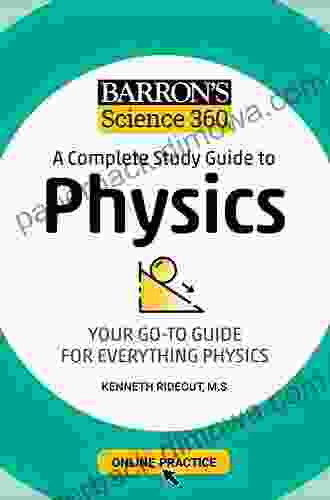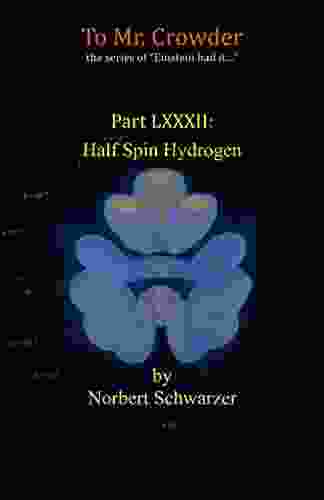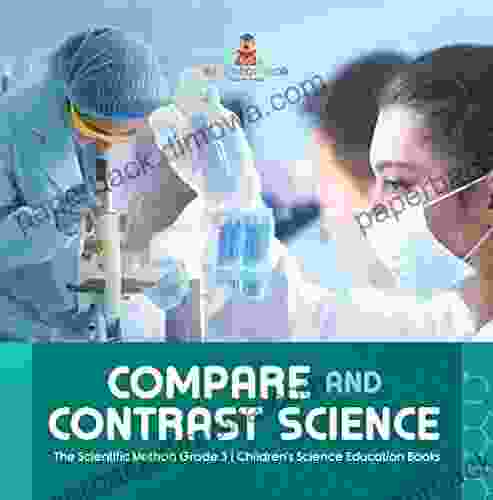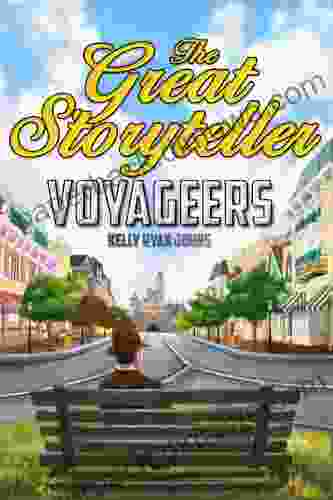Compare and Contrast Science: The Scientific Method Grade Children Science

Science is a fascinating subject that helps us understand the world around us. It is a way of thinking and investigating that can be used to solve problems and make new discoveries. The scientific method is a process that scientists use to conduct experiments and collect data. It is a systematic approach that helps to ensure that the results of an experiment are accurate and reliable.
What is the Scientific Method?
The scientific method is a step-by-step process that scientists use to investigate a problem. It involves making observations, forming a hypothesis, testing the hypothesis, and drawing s.
5 out of 5
| Language | : | English |
| File size | : | 22966 KB |
| Screen Reader | : | Supported |
| Print length | : | 72 pages |
| X-Ray for textbooks | : | Enabled |
| Paperback | : | 186 pages |
| Item Weight | : | 2.16 pounds |
| Dimensions | : | 6.14 x 1.31 x 9.21 inches |
| Hardcover | : | 620 pages |
- Observation: The first step in the scientific method is to make observations about the world around you. These observations can be about anything, from the weather to the behavior of animals.
- Hypothesis: Once you have made some observations, you can start to form a hypothesis. A hypothesis is a tentative explanation for a phenomenon. It is based on your observations and prior knowledge.
- Test: The next step is to test your hypothesis. This involves designing and conducting an experiment. The experiment should be designed to test your hypothesis and collect data that will either support or refute it.
- : The final step in the scientific method is to draw s. This involves analyzing the data from your experiment and determining whether or not your hypothesis was supported. If your hypothesis was supported, you can conclude that it is a valid explanation for the phenomenon you observed.
How Can the Scientific Method Be Used in the Classroom?
The scientific method can be a valuable tool for teaching children about science. It can help them to develop critical thinking skills, problem-solving skills, and communication skills. Here are a few ways that the scientific method can be used in the classroom:
- Science experiments: Science experiments are a great way to teach children about the scientific method. They can design and conduct their own experiments to test hypotheses about the world around them.
- Science projects: Science projects can be a more in-depth way for children to learn about the scientific method. They can choose a topic that they are interested in and research it, design and conduct an experiment, and present their findings.
- Science demonstrations: Science demonstrations can be a fun and engaging way to teach children about the scientific method. They can watch a scientist perform an experiment and then discuss the results.
Benefits of the Scientific Method
There are many benefits to using the scientific method in the classroom. Some of these benefits include:
- Develops critical thinking skills: The scientific method requires children to think critically about the world around them. They must be able to make observations, form hypotheses, and test them.
- Develops problem-solving skills: The scientific method is a problem-solving process. Children must be able to identify a problem, research it, and develop a solution.
- Develops communication skills: The scientific method requires children to communicate their findings to others. They must be able to write reports, give presentations, and discuss their work.
- Helps children to learn about the world around them: The scientific method is a way of learning about the world around us. Children can use it to investigate anything that they are interested in.
The scientific method is a valuable tool for teaching children about science. It can help them to develop critical thinking skills, problem-solving skills, and communication skills. By using the scientific method in the classroom, you can help your students to become lifelong learners who are able to think critically about the world around them.
Compare and Contrast Science: The Scientific Method Grade Children Science is a great resource for teachers who want to learn more about the scientific method. This book provides a comprehensive overview of the scientific method, as well as detailed instructions for how to use it in the classroom.
With Compare and Contrast Science: The Scientific Method Grade Children Science, you can help your students to become successful scientists who are able to make a difference in the world.
5 out of 5
| Language | : | English |
| File size | : | 22966 KB |
| Screen Reader | : | Supported |
| Print length | : | 72 pages |
| X-Ray for textbooks | : | Enabled |
| Paperback | : | 186 pages |
| Item Weight | : | 2.16 pounds |
| Dimensions | : | 6.14 x 1.31 x 9.21 inches |
| Hardcover | : | 620 pages |
Do you want to contribute by writing guest posts on this blog?
Please contact us and send us a resume of previous articles that you have written.
 Book
Book Novel
Novel Page
Page Chapter
Chapter Text
Text Story
Story Genre
Genre Reader
Reader Library
Library Paperback
Paperback E-book
E-book Magazine
Magazine Newspaper
Newspaper Paragraph
Paragraph Sentence
Sentence Bookmark
Bookmark Shelf
Shelf Glossary
Glossary Bibliography
Bibliography Foreword
Foreword Preface
Preface Synopsis
Synopsis Annotation
Annotation Footnote
Footnote Manuscript
Manuscript Scroll
Scroll Codex
Codex Tome
Tome Bestseller
Bestseller Classics
Classics Library card
Library card Narrative
Narrative Biography
Biography Autobiography
Autobiography Memoir
Memoir Reference
Reference Encyclopedia
Encyclopedia Kelly Loy Gilbert
Kelly Loy Gilbert Kathryn Williams
Kathryn Williams Kathy Schwalbe
Kathy Schwalbe K B Akhilesh
K B Akhilesh Robert Grayson
Robert Grayson Yen Rickeard
Yen Rickeard Susan Burke
Susan Burke Timothy Patrick Mccarthy
Timothy Patrick Mccarthy K A Linde
K A Linde Sourajit Aiyer
Sourajit Aiyer Marcia Thornton Jones
Marcia Thornton Jones Keith Stewart
Keith Stewart Matt Rogan
Matt Rogan Kase Johnstun
Kase Johnstun Justin Doherty
Justin Doherty Justin Mader
Justin Mader P Michael Conn
P Michael Conn Keegan Dresow
Keegan Dresow Rizwan Shah
Rizwan Shah Megan Squires
Megan Squires
Light bulbAdvertise smarter! Our strategic ad space ensures maximum exposure. Reserve your spot today!

 Jedidiah HayesThe Network Marketing Academy: A Comprehensive Guide to Building a Successful...
Jedidiah HayesThe Network Marketing Academy: A Comprehensive Guide to Building a Successful...
 Jorge Luis BorgesPractical Guide For The Player Coach And Family In The Sport Of Rugby Union
Jorge Luis BorgesPractical Guide For The Player Coach And Family In The Sport Of Rugby Union Dan HendersonFollow ·12.9k
Dan HendersonFollow ·12.9k Jerome BlairFollow ·18.5k
Jerome BlairFollow ·18.5k Cristian CoxFollow ·14.3k
Cristian CoxFollow ·14.3k William PowellFollow ·3.2k
William PowellFollow ·3.2k Branden SimmonsFollow ·11.7k
Branden SimmonsFollow ·11.7k Virginia WoolfFollow ·16.2k
Virginia WoolfFollow ·16.2k Jack ButlerFollow ·12.9k
Jack ButlerFollow ·12.9k Zadie SmithFollow ·13.2k
Zadie SmithFollow ·13.2k

 Reginald Cox
Reginald CoxUnlocking the Secrets of Corporate Finance: Explore the...
In the ever-evolving world of business, a...

 David Peterson
David PetersonUncover the Depths of Steinbeck's 'Of Mice and Men' with...
Unlock New Insights and Conquer Your Exams ...

 John Keats
John KeatsUnveiling the Heart-Tugging Memoirs of Soldier Friend: A...
Step into the extraordinary world of...

 Chad Price
Chad PriceUnlock Physics Mastery with Barron's Comprehensive Study...
Elevate your physics...

 Dave Simmons
Dave SimmonsEinstein Had It Part Lxxxii: Half Spin Hydrogen
In the realm of...
5 out of 5
| Language | : | English |
| File size | : | 22966 KB |
| Screen Reader | : | Supported |
| Print length | : | 72 pages |
| X-Ray for textbooks | : | Enabled |
| Paperback | : | 186 pages |
| Item Weight | : | 2.16 pounds |
| Dimensions | : | 6.14 x 1.31 x 9.21 inches |
| Hardcover | : | 620 pages |










